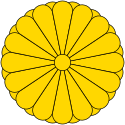Ashiya
| |||||||
 | |||||||
| |||||||
| Państwo | |||||||
|---|---|---|---|---|---|---|---|
| Prefektura | |||||||
| Wyspa | |||||||
| Region | |||||||
| Burmistrz | Mai Itō | ||||||
| Powierzchnia | 18,57 km² | ||||||
| Populacja (2018[1]) • liczba ludności • gęstość |
| ||||||
| Kod pocztowy | 659-8501 | ||||||
| Symbole japońskie | |||||||
| Drzewo | Czarna sosna | ||||||
| Kwiat | Rhododendron reticulatum | ||||||
| Strona internetowa | |||||||
| Portal | |||||||
Ashiya (jap. 芦屋市 Ashiya-shi) miasto w Japonii (prefektura Hyōgo) położone pomiędzy Kobe a Osaką[2].
Położenie
Miasto leży w południowo-wschodniej części prefektury między Kobe a Osaką, graniczy z miastami:
Historia
Miasto powstało 10 października 1940. 17 stycznia 1995 poważnie ucierpiało podczas wielkiego trzęsienia ziemi w Kōbe.
Literatura związana z miastem
W Ashiya znajduje się Tanizaki Junichiro Memorial Museum of Literature (芦屋市谷崎潤一郎記念館 Ashiya-shi Tanizaki Jun’ichirō Kinenkan), muzeum pamięci poświęcone pisarzowi Jun’ichirō Tanizaki[3]. W tym też mieście toczy się częściowo akcja powieści Sasameyuki (Drobny śnieg, 1948)[4].
W latach 50. i 60. mieszkał z rodzicami i uczęszczał do niższej szkoły średniej (gimnazjum) w Ashiya inny pisarz, Haruki Murakami (ur. 1949 r.)[5], a na stałe mieszka w tym mieście laureatka wielu nagród literackich, w tym Nagrody im. Akutagawy, Yōko Ogawa (ur. 1962)[6].
Miasta partnerskie
 Stany Zjednoczone: Montebello
Stany Zjednoczone: Montebello
Przypisy
- ↑ City emblem and demographic, social and economic conditions in a city. Ashiya City, 2018. [dostęp 2019-11-05]. (ang.).
- ↑ 日本地図. Tokyo: Seibido Shuppan, 2018, s. 203. ISBN 978-4-415-11272-5.
- ↑ Tanizaki Junichiro Memorial Museum of Literature, Ashiya. Navitime Japan, 2019. [dostęp 2019-11-05]. (ang.).
- ↑ Mikołaj Melanowicz: Historia literatury japońskiej. Warszawa: PWN, 2012, s. 347, 433, 444. ISBN 978-83-01-17214-5.
- ↑ Haruki Murakami. Cool Japan Illustrated, 2019. [dostęp 2019-11-05]. [zarchiwizowane z tego adresu (2019-10-20)]. (ang.).
- ↑ Yōko Ogawa. Goodreads, Inc., 2019. [dostęp 2019-11-05]. (ang.).
Media użyte na tej stronie
Autor: Maximilian Dörrbecker (Chumwa), Licencja: CC BY-SA 3.0
Location map of Japan
Equirectangular projection.
Geographic limits to locate objects in the main map with the main islands:
- N: 45°51'37" N (45.86°N)
- S: 30°01'13" N (30.02°N)
- W: 128°14'24" E (128.24°E)
- E: 149°16'13" E (149.27°E)
Geographic limits to locate objects in the side map with the Ryukyu Islands:
- N: 39°32'25" N (39.54°N)
- S: 23°42'36" N (23.71°N)
- W: 110°25'49" E (110.43°E)
- E: 131°26'25" E (131.44°E)
The flag of Navassa Island is simply the United States flag. It does not have a "local" flag or "unofficial" flag; it is an uninhabited island. The version with a profile view was based on Flags of the World and as a fictional design has no status warranting a place on any Wiki. It was made up by a random person with no connection to the island, it has never flown on the island, and it has never received any sort of recognition or validation by any authority. The person quoted on that page has no authority to bestow a flag, "unofficial" or otherwise, on the island.
Emblem of Ashiya, Hyogo
Flag of Ashiya, Hyogo












